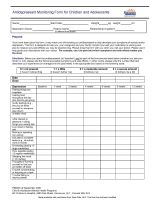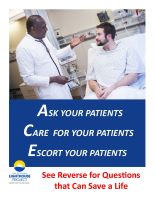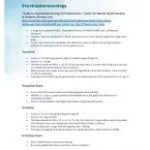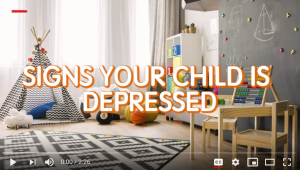Introduction and Overview
The following resources are widely used in clinical settings to screen and assess, design treatment protocol, prescribe medication and provide referrals for children and adolescents with symptoms of depression.
Screening & Assessment
 Patient Health Questionnaire (PHQ)
Patient Health Questionnaire (PHQ)
The PHQ is a brief, two item screening instrument. A positive response to either question indicates further testing.
 PHQ-9 modified for Adolescents (PHQ-A)
PHQ-9 modified for Adolescents (PHQ-A)
The PHQ-A is a questionnaire assessing anxiety, mood, eating disorders, and SUD among adolescents.
 Antidepressant Monitoring Form for Children and Adolescents
Antidepressant Monitoring Form for Children and Adolescents
A tool to help caregivers or healthcare staff monitor how medication is working and side effects that may be experienced.
 Columbia-Suicide Severity Rating Scale (C-SSRS)
Columbia-Suicide Severity Rating Scale (C-SSRS)
The C-SSRS is designed for professionals to assess suicide risk, with several versions tailored to varied settings or populations.
Treatment
Evidence-Based Treatments for Major Depressive Disorder in Adolescents
Popular Psychosocial Treatments:
- Cognitive Behavioral Therapy (CBT) and medication
- CBT
- CBT with parents
- Family therapy
Cognitive Behavioral Therapy (CBT) is a common psychosocial intervention used to help individuals and families experiencing depression. The University of Washington’s Harborview Medical Center shares several CBT therapist resources that can be used by clients and/or healthcare professionals.
Therapist Aid is a great resource to find CBT tools.
 Psychopharmacological Treatments:
Psychopharmacological Treatments:
A list of psychopharmacology interventions commonly uses by pediatricians.
Referral and Co-Management
Psychiatry Referral Criteria
- Severe depression
- Co-morbid substance abuse
- Co-occurring autism
- Psychotic/bipolar symptoms
- Severe psychosocial impact
- Previous episodes
- Prior suicide attempt
- Strong family history
- 2 failed SSRI trials
- PCC or parent discomfort with PCC managing alone
While Awaiting a Referral
- Find agreement on goals and steps to reduce stress
- Find agreement on healthy activities (eg, exercise, time outdoors, limits on media, balanced and consistent diet, sleep [!!!!], one-on-one time with parents, reinforcement of strengths, open communication, pro-social peers)
- Educate family, de-mystify the condition, and support them in monitoring for worsening of symptoms or emergencies
- Initiate care (even if planning referral) using “common factors” and/or “common elements” of evidence-based Rx
- Monitor progress (eg, telephone, electronic communication, return visit)
- Provide assistance with referral
Co-Management with Mental Health Professional
- Established referral relationship
- Warm hand off to both therapist and psychiatrist
- Standardized exchange of information (see AAP-AACAP joint HIPAA statement on communication between PCC and MHP www.aap.org/mentalhealth click on Key Resources, then HIPAA Privacy Rule and Provider to provider Communication) with both therapist and psychiatrist
- Shared record if integrated or co-located
Medication
Fluoxetine
- Comes in: 10,20,40 mg (capsule; only 10 is tablet); liquid 20mg/5ml
- Start at: 5 or 10 mg
- Titration schedule to effect: 5, 10, 20, 30, 40; one step every 1-2 weeks until 20 mg; then increase at 1 month intervals because of time to efficacy.
- Most common dose range: 20-40 mg; max is 60 mg (if titrate to 60 with no effect – time to switch or refer to psychiatry)
- FDA approved for MDD (age 8); good evidence for anxiety disorders (FDA approved for OCD, age 7)
MDD:
Lower weight Children
- Start at: 10 mg once daily; usual daily dose: 10 mg/day; if needed, may increase dose to 20 mg once daily after several weeks
- Maximum daily dose: 20 mg/day
Higher weight Children and Adolescents:
- Start at: 10 to 20 mg once daily; in patients started at 10 mg once daily, may increase dose to 20 mg after 1 week
- Maximum daily dose: 20 mg/day
Fluoxetine Pearls
- Dose in the AM because tends to be activating (particularly initially)
- Half-life is 2-5 days, so good option for teen/family who is not good with adherence to medication schedule
- Potent CYP2D6 inhibitor with higher potential for drug-drug interactions
Sertraline
- Comes in: 25, 50, 100 mg tabs; liquid 20 mg/1ml
- Start at: 12.5 mg (1/2 tab)
- Titration schedule to effect: 12.5, 25, 50, 75, 100, 150, 200; first 3 steps within 3 weeks if possible and tolerated; then each subsequent step q month due to time to efficacy
- Most common dose range: 100-200 mg/day; max – 200 mg
- FDA approved (age 6) OCD; good evidence for anxiety disorders; some evidence for MDD
Sertraline Pearls
- Dose in AM because somewhat activating
- But some patients feel more tired; if so, switch to bedtime
Escitalopram
- Comes in: 5, 10, 20 mg; liquid 5mg/5ml
- Start at: 10 mg
- Titration schedule to effect: 5, 10, 15, 20; go to 10 mg after the first 1-2 weeks if tolerated; may be increased to 20 mg after 3 weeks.
- Most common dose range: 10-20 mg. Maximum dose 20 mg
- FDA approved for MDD (age 12)
Duloxetine
Children 6 to 12 years
- Start at: 12.5 to 25 mg once daily
- Titrate dose upwards if clinically needed; may increase by 25 to 50 mg/day increments at intervals of at least 1 week; mean final dose in 21 children (8 to 18 years of age) was 100 ± 53 mg or 1.6 mg/kg/day (n=11); range: 25 to 200 mg/day
- Maximum daily dose: 200 mg/day (Dopheide 2006; Tierney 1995)
- Avoid excessive dosing
Adolescents 13 to 17 years:
- Start at: 25 to 50 mg once daily
- Titrate dose upwards if clinically needed; may increase by 50 mg/day increments at intervals of at least 1 week; mean final dose in 13 adolescents was 110 ± 50 mg or about 2 mg/kg/day (McConville 1996); in another study using a slower titration, the mean dose at week 6 was 93 mg (n=41) and at week 10 was 127 mg (n=34) (Ambrosini 1999); range: 25 to 200 mg/day;
- Maximum daily dose: 200 mg/day
Billing/Coding
96160
- Can code two per visit
- Code pays $7.91 (at well visit and at E+M visit)
- Examples: Bright Futures Adolescent Supplemental Questionnaire, GAPS, HEADSSS
96127
- Can code two per visit
- Code pays $4.10 (at well visit and at E+M visit)
- Examples: PSC, SCARED, CDI, CES-DEC, PHQ-9 Modified for Adolescents, Vanderbilt, Conners
99408
- May be reported in addition to E/M or Health Check
- Code pays $30.73 (only code if screen is positive & counseling is documented from 3-15 minutes)
- Examples: CRAFFT for Substance Use/Abuse
Additional Resources for Families
Websites
Childhood Depression: Anxiety and Depression Association of American provides an overview of signs, symptoms, and treatments for childhood depression.
Teen Depression: The Mayo Clinic identifies the signs, risk factors, and prevention for teenage depression.
Parenting a Depressed Teenager: Tips and support for families to foster a safe and supportive relationship with their depressed child.
A mental health check-in, 14 questions to ask your child: Dr. Eli Lebowitz, Program for Anxiety Disorders at Yale Child Study Center, provides key questions to ask children.
Podcast
Teens & Depression: Practically Perfect Parenting podcast about the difference between normal sadness and depression, medication treatments for youth who have depression, and other treatment alternatives.
When Depression Hits, Teens Find Help from NPR
Helping Teens Cope with Anxiety, Depression & More: On Boys podcast discusses the mental health of young boys.
Apps
Top Apps for Depression: Healthline reviews the top apps for supporting people with depression.
Fact Sheets
Children and Mental Health, Is it just a stage: National Institute of Mental Health provides a short guide for signs, symptoms, and treatment options for childhood depression.
Quick overview of Depression: Provided by the National Alliance on Mental Illness
Common Warning Signs of Mental Illness: Provided by National Alliance of Mental Illness
Articles
A Rise In Depression Among Teens And Young Adults Could Be Linked To Social Media Use: NPR review of a study linking iGen youth depression to social media.
A child's home environment can impact the risk of developing depression: Science Daily reviews research linking childhood environments to the risk of depression in adulthood.
Books
Anxiety and Depression: Association of America compiled a list of books on childhood and teenage depression.






